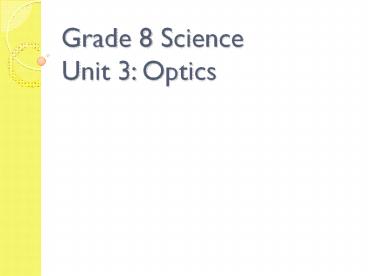Grade 8 Science Unit 3: Optics - PowerPoint PPT Presentation
1 / 36
Title:
Grade 8 Science Unit 3: Optics
Description:
Grade 8 Science Unit 3: Optics CORE LAB ACTIVITY 5-1D FOLLOW THAT REFRACTED RAY! The Ray Model of Light Used to study the behaviour of light when it meets a ... – PowerPoint PPT presentation
Number of Views:351
Avg rating:3.0/5.0
Title: Grade 8 Science Unit 3: Optics
1
Grade 8 ScienceUnit 3 Optics
2
The Ray Model of Light
- Used to study the behaviour of light when it
meets a surface. - Light is represented by a straight line or ray
that shows the direction the light is travelling.
3
Transparent
Opaque
Allows light to pass through freely. Only a
small amount of light is absorbed or reflected.
Prevents any light from passing through it. It
will only absorb or reflect light.
Different Materials
Translucent
Most light rays pass through, but are scattered
in all directions.
4
Light travels in a straight line.
Rectilinear Propagation
Shadow
Solid Object
5
Reflection...
- Incident light ray
- the incoming light ray
- Reflected light ray
- the ray that bounces off the barrier
6
- Normal
- An imaginary line that is perpendicular to the
barrier.
Normal
Reflected Ray
Incident Ray
7
- Angle of incidence
- The angle formed by the incident ray and the
normal. - Angle of reflection
- The angle formed by the reflected ray and the
normal.
8
Reflection
9
Specular vs. Diffuse Reflection
- Applications of Specular and Diffuse Reflection
- Countertop surfaces
- Furniture or car wax
- Glazed vs, unglazed ceramics
- Matte vs. Glossy finish on photographs or in paint
10
Determining the Laws of Reflection
- Using a Ray Box
11
Laws of Reflection
- The angle of incidence equals the angle of
reflection.
12
Core lab Activity 5-2 BPage 192Demonstrating
the Laws of Reflection
13
Types of Mirrors
- 1. Plane Mirrors
- A flat, smooth mirror
14
- Characteristics of images using plane mirrors
- Image size is equal to object size
- Image distance is equal to object distance
- The image is upright
- The image is virtual
15
Plane Mirrors
16
- Examples of plane mirrors
- Bathroom mirrors
- Rear view mirrors
- Dentist mirror for looking at teeth
- Periscopes
17
- 2. Concave Mirrors
- Have a reflecting surface that curves inward like
the inside of a bowl.
18
- Characteristics of images using concave mirrors
(depends on the position of the object) - It can be smaller, larger or the same size
- It can be upright or inverted
- It can be actual or virtual
19
Concave Mirrors
20
- Examples of concave mirrors
- Inside a metal spoon
- Spotlights
- Overhead projectors
- Flashlights
- Car headlights
- Lighthouses
- Satellite dishes
21
- 3. Convex Mirrors
- Curved outward like the outside of a bowl.
22
- Characteristics of images using convex mirrors
- The image is smaller than the object.
- The image distance is smaller than the object
distance. - The image is upright.
- The image is virtual.
23
- Examples of convex mirrors
- Safety mirrors at the front of a bus
- Side view mirrors of vehicles
- Disco balls
24
Ray Diagrams...parts to know
25
Core Lab ActivityRay Diagrams using concave
mirrors
26
Real Vs. Virtual Images
- Real Image
- Formed when reflected rays (not extended rays)
meet - Located in the front of the mirror
- You need a screen to see the real image
27
- Virtual Image
- Formed when the reflected rays are extended
- Located behind the mirror
28
Refraction...
- The bending of a wave when it travel from one
medium to another.
29
- Refracted ray
- is in the second medium travelling in a different
direction than the incident ray. - Angle of refraction
- The angle between the normal and the refracted
ray.
30
Refraction
31
What happens...
- As light travels from a less dense medium to a
more dense medium (ie. Slows down)? - The ray bends towards the normal.
32
- As light travels from a more dense medium to a
less dense medium (ie. Speeds up)? - The ray bends away from the normal.
33
Why is the object not where you think it is?
- If the light travels through two different media
before it reaches your eyes, it does not travel
in a straight line. - The object is not where your brain thinks it is.
34
(No Transcript)
35
(No Transcript)
36
Core Labactivity 5-1DFollow that refracted
ray!

